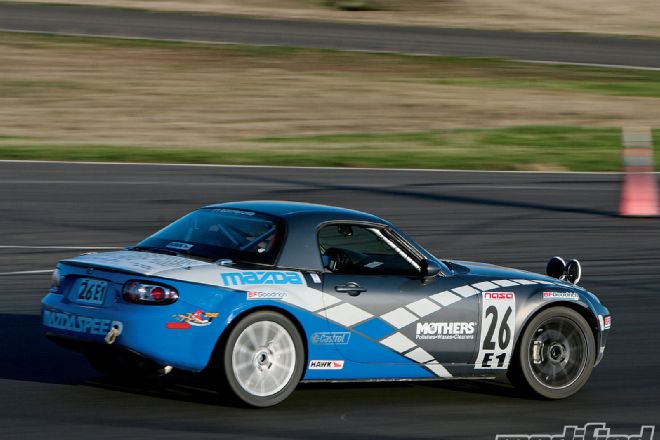While corresponding with Roberts Kukainis, BFGoodrich's motorsports manager, he mentioned that a team at the 25 Hours of Thunderhill in December ran the entire race with the same BFG g-Force R1 tires and only changed the left/rear because of damage it sustained from contact with another car. Having run on R1s at the last three 25 Hours of Thunderhill endurance road races myself (you can read all about my latest 25 Hour adventure on page 46), this DOT-approved R-compound tire has continued to impress me more every year. From the driver seat, these tires provide impressively high grip levels-certainly on par with the fastest DOT track tire I've tried-but as Roberts' story highlights, the engineers at BFG have also found a way to make the R1 incredibly durable.
 |
BFGoodrich g-Force R1 - The Ultimate 25 Hour Racing Tire? - Tech Talk
|
BFGoodrich g-Force R1 - The Ultimate 25 Hour Racing Tire? - Tech Talk
In an attempt to figure out how BFG's R1 track tire defies what I had assumed to be an immutable law of racing tire performance (high grip = rapid tread wear), I've taken every opportunity I could to quiz the company's tire engineers over the last few years, including during and after the '09 25 Hour race back in December. Obviously, they haven't been inclined to give away the farm by providing their secret formula just because I've tried every schoolyard trick I could think of, but I've managed to squeeze some interesting insights out of them. Here's what I've learned so far.
Although the g-Force R1 has only been on the market for a few years now, its compound has actually been in development for a long time. That's because the compound used for the R1 is closely related to the Trans Am racing slicks BFG perfected during the '90s. Knowing that the basic compounding of the R1 stems from a pure racing slick goes a long way to explaining the high level of grip I've experienced while piloting a number of different race cars equipped with this rubber. During one of my first tests of the R1, at Virginia International Raceway in a modified S2000, in-car data (from a VBox GPS-based data acquisition system) showed a maximum of 1.7g of lateral acceleration and a sustained 1.5g in the corners. These cornering g-forces significantly exceed what I've been able to achieve around VIR using a number of different DOT R-compound tires on similarly prepared vehicles, including my own race car.
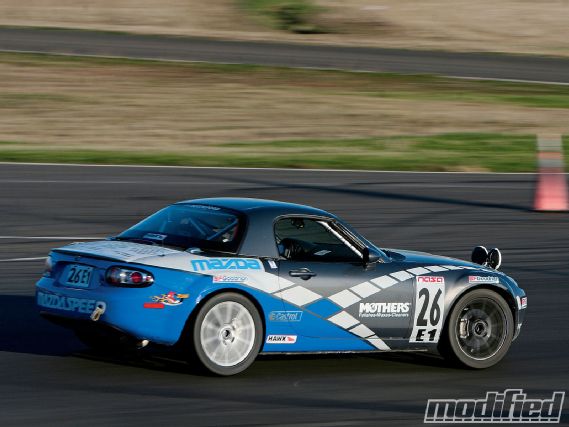 |
During my one-hour stint in this Mazda MX-5 at the 25 Hours of Thunderhill, the BFGoodrich g-Force R1 tires it was equipped with provided consistently high grip levels.
|
During my one-hour stint in this Mazda MX-5 at the 25 Hours of Thunderhill, the BFGoodrich g-Force R1 tires it was equipped with provided consistently high grip levels.
But the R1 is far from just a rebranded Trans Am racing slick. To meet all the requirements of a DOT (street-legal) tire, a lot of fresh thinking had to go into its overall construction. The DOT is primarily concerned with how much load a tire can endure at low inflation, say when a tire suffers a puncture. They want to ensure the car won't rapidly and dangerously lose control, so to pass the DOT test a tire is run in a test cell at 90 to 100 degrees, where the tire's bead, carcass, tread and belt design must withstand running at low inflation. This requires a tire that is both thermally and dimensionally stable.
To achieve the required level of thermal and dimensional stability for DOT certification, BFG's tire engineers spent a lot of time focusing their efforts on what brand manager Doug Brown referred to as "belt mechanics." As Doug explained to me while chatting in the paddock at the '08 25 Hour race, "Tires actually have more moving parts than a V-8 engine. People tend to think of tires as just simple rubber donuts, but if you look beneath the surface and visualize all the strands of nylon in the cap and wires in the belt, all of which vibrate or resonate individually within the tire, you'll begin to understand that a tire is a very complex system of moving parts that need to work in unison for optimum performance. So we worked very hard on the way the R1 presents itself to the road with respect to belt mechanics, since this goes a long way toward determining its overall performance and ability to meet DOT requirements."
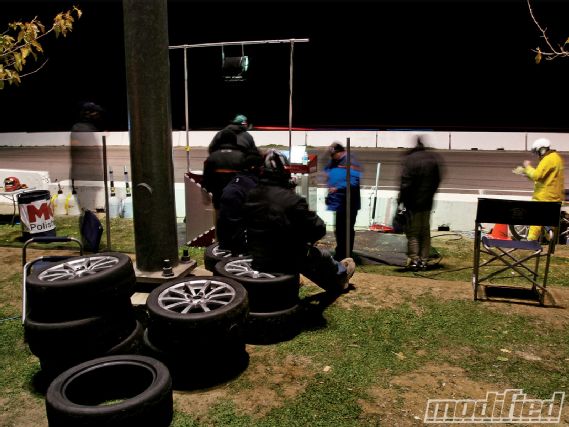 |
As proof of the R1's durability, this small pile of rubber is all our Mazda needed to complete 25 continuous hours of racing. Amazing!
|
As proof of the R1's durability, this small pile of rubber is all our Mazda needed to complete 25 continuous hours of racing. Amazing!
When I asked Doug for an example of how belt mechanics and resonance within the rubber affects tire performance, he said, "Rubber stiffness changes depending on how quickly you cycle [or vibrate] it. By doing some things with the belt, we can control how much the rubber is 'exercised' or vibrated, and this in turn allows us to control compound temperature and the responsiveness of the rubber. We call this frequency response or material/tread response, and it's a very important part of the engineering process when developing a tire like the R1."
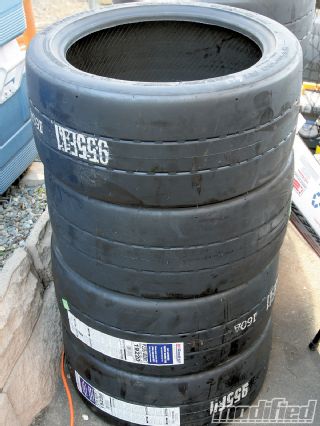 |
Some fresh R1s await their turn to endure countless hours of nonstop abuse during the 25 Hour race. On the left (less abused) side of the car, these lasted most teams at least 12 hours, while on the right (more abused) side they lasted most teams six to seven hours at Thunderhill.
|
Some fresh R1s await their turn to endure countless hours of nonstop abuse during the 25 Hour race. On the left (less abused) side of the car, these lasted most teams at least 12 hours, while on the right (more abused) side they lasted most teams six to seven hours at Thunderhill.
So although the BFG R1 uses a compound designed originally for use on their Trans Am racing slicks, through advanced engineering including belt mechanics and resonance control, the R1 has been tuned for consistency and durability without having to sacrifice grip. But that's not to say the R1 is somehow a magical do-everything tire. In testing I've found the R1 is slower to come up to operating temperature (measured using a probe-type pyrometer) than many of the other DOT R-compound tires I've tried, and people from BFG's technical staff have told me they've received similar feedback from many other R1 users.
According to Kip Newton from BFG, "The R1 was designed to run throughout a whole weekend at the track, so it does take longer to warm up than some tires designed specifically for time attack or autocross, but once hot it will perform very consistently and last a long time. To improve time attack performance when using the R1, start with a higher tire pressure. This will shock the tire harder, build heat more quickly and provide more base with the higher starting pressures. More toe, more camber and stiffer shocks and springs will also help build heat in the tire when competing in a time attack format. Ideally, you want about 20 degrees more inside tire temp [meaning the inner third of the contact patch]. If you don't see that much temperature difference, you don't have enough camber."
Another common piece of feedback BFG has received about the R1 is that its slip angle is peakier than some of the other DOT R-compound tires on the market. What this means is that as the R1 approaches its peak grip level, when you push the tire beyond this peak there's a fairly steep drop off in available grip. This can result in an oversteer or understeer situation arising quite rapidly, which demands a quick response from the driver to counteract. So the R1 isn't the most forgiving DOT track tire on the market, but as Kip pointed out, the higher the grip potential of a tire the higher/steeper the drop off tends to be from its peak. So there's a trade-off between ultimate grip and slip angle friendliness, but if you've raced on other high-grip R-compound tires before, then this is a performance characteristic you'll be familiar with. It's really only likely to catch drivers who have done all their previous high-performance/race driving on street tires or less sticky DOT track tires.
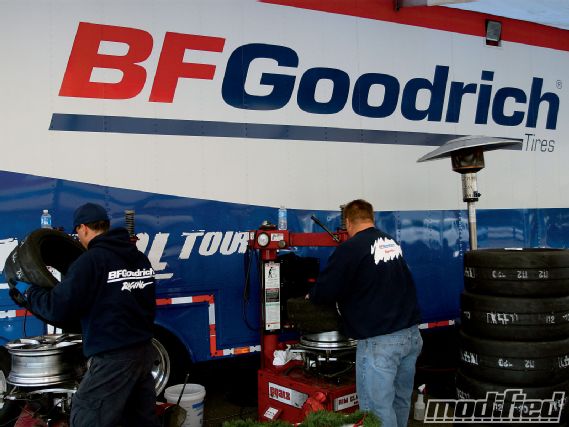 |
In support of the 13 teams running on R1s at the 25 Hour race, BFGoodrich brought out its big rig for tire changing.
|
In support of the 13 teams running on R1s at the 25 Hour race, BFGoodrich brought out its big rig for tire changing.
There are, of course, many excellent options in the highly competitive DOT track-tire segment. Some are best suited to autocross or time attack use, like the Hoosier A6 and Kumho V710, because they heat up quickly and use a very soft compound. Other options, like the Toyo R888 and Yokohama A048R, are more street-friendly because they have a tread pattern that allows for better rain performance and use compounds that are more resistant to heat cycle degradation. But if your track tire needs involve prolonged use, say during a HPDE or race weekend, you'd be hard pressed to find a DOT track tire that offers a better combination of grip and durability than the BFGoodrich g-Force R1.
Send your feedback to dpratte@modified.com

